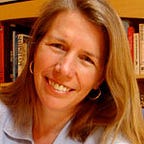The most important delegation of COP22
For the last ten years, an unlikely delegation has helped to shape vital information coming out of COP, the annual United Nations Framework Convention on Climate Change. It’s not a powerful committee of statesmen. It’s not a global media channel. It’s not a fly-in of Hollywood stars and activists.
It’s a group of reporters, led by James Fahn of Internews, that hail from far flung corners of the world. And in many cases, it’s their countries and their homes that will be hit hardest by climate change.
This group, the Climate Change Media Partnership (CCMP), has produced more than 3,000 stories, funded more than 241 journalists to attend, and in the process, they’ve created an earpiece — and a voice — for some of climate change’s worst-affected communities.
The Earth Journalism Network (EJN) was started at Internews in 2004 to empower and enable journalists from developing countries to cover the environment more effectively, improving the quantity and quality of environmental coverage.
Under Fahn’s leadership, the network now has more than 9,000 members who have reported tens of thousands more stories beyond COP coverage. They’re changing the media environment and their communities, one story at a time.
Take Yolandi Groenewald, for example, from South Africa. She got her start at the Mail and Guardian as an intern and ended up working there for 10 years under award-winning environmental journalist Fiona MacLeod, who she credits for inspiring her to make a career as an environmental journalist.
“It wasn’t until I started working with Fiona that environmental journalism really started to take off for me. I found early on that while South Africa plays an important role in COP, our domestic policy does not always reflect what we promise on the world stage. It’s been my desire to change that and to educate South Africans on the proceedings. Enviro journalists are a dying breed, but that’s changing as our networks grow stronger.”
After attending last year’s COP21 in Paris, Groenewald has since received numerous fellowships and grants to cover wildlife trafficking and poaching issues in South Africa. She now writes for MacLeod’s Oxpeckers Center for Investigative Environmental Journalism, Africa’s first journalistic investigation unit focusing on environmental issues. The center recently won an award at the CNN Multichoice African Journalist Awards for their work on a 10-month long investigation on black rhino poaching in Namibia. Groenewald runs Oxpecker’s ClimaTracker initiative and trains future EJN journalists in environmental reporting.
Meanwhile, this is Purple Romero’s first year at COP as a journalist, representing the Philippines. She applied to the CCMP fellowship back in 2011, but as a green reporter new to the scene, she didn’t make the cut. But she persisted, joined the last three COPs as part of the Philippine delegation, and has now written environmentally focused articles for top publications like Reuters, Rappler, Climate Home and GMA. This year, Purple made it as a journalist.
For the last two years, Purple has been following the role of human rights in the climate change proceedings after the Philippines first introduced the issue at COP20. Its importance was considered largely quashed in the final COP21 Paris agreement with only a passing mention. So, this year she will be focusing special attention on how human rights are addressed at COP22.
On the domestic front, Purple has been covering the Philippines Department of Energy’s reliance on coal and the public backlash demanding use of cleaner energy sources. For her, coverage is not only about educating Filipino audiences, but being the voice of the disenfranchised. “My mother’s family is a family of fisherman. They see the effects of climate change and environmental destruction on their communities every day. But in the news, you tend to only read about the environment on a slow news day. Changing that is what’s important to me. We are starting to see the number of stories increasing, and with it, our ability to put pressure on agencies like the Department of Energy.”
Innocent Onoh is accompanying Purple at this year’s COP. He heads the Environmental Unit of Africa’s largest radio network, the Federal Radio Corporation of Nigeria, which has over 40 FM radio stations across the country and beyond. He has been covering the environment in Nigeria for nine years in addition to his coverage of presidential and diplomatic visits. He sees his job as “keeping the government on its toes,” he says, “If we are to solve our planet’s greatest climate challenges, we need scientists at the table, not just politicians.” And what happens at that table then needs to be distilled and explained to the public by reporters whose skills in environmental topics have been well honed.
Innocent’s coverage has spanned from the Great Green Wall Initiative (the desertification prevention plan for the Sahel), to food security in the Arochukwu region, to the potential for solar electricity in Nigeria, to the country’s ratification of the Paris Agreement last year, and more.
The stakes are high for these countries and others like them, where informative and actionable coverage of climate change is more than just about environment, it’s a matter of national security. According to the UN, climate change could drive as many as 122 million people into extreme poverty by 2030, if we don’t do anything to stop it.
“What’s happening in our environment has the ability to reshape borders, alter economies and displace large populations,” Fahn says. “We have to understand the scope of the challenge and meet that head on. The first and most important tool we have is information, and journalists like these exemplary reporters are critical to that picture.”
Purple and Innocent are among the 15 EJN journalists attending this year’s COP. To read their coverage of this year’s meetings and stories of their colleagues, check out www.earthjournalism.net.
